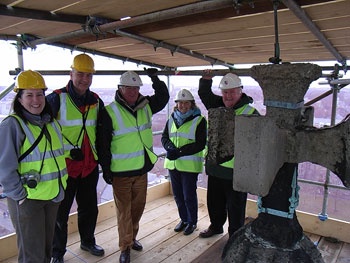A once-in-a-generation opportunity is now available to see traditional medieval construction technology at work on one of Aberdeen and Scotland’s best-loved landmarks.
Work now underway to restore the Crown Tower of King's College Chapel in Old Aberdeen, is attracting historians and conservation groups from across the north of Scotland - keen to see how stonemasonry perfected five hundred years ago is today preserving a historic building for the enjoyment of future generations of students, local people and visitors from around the world.
The award-winning partnership of Acanthus Architects Douglas Forrest, Laing Traditional Masonry and the Estates Team of the University of Aberdeen have teamed up again to undertake this project, which is being supported by a grant of £58,000 from the Aberdeen City Heritage Trust. The partnership has previously won awards for the sensitive restoration of the distinctive Powis Gates in Old Aberdeen.
The work on the scaffolding-encased Tower involves a team of specialist craftsmen using traditional 16th century techniques to repair the masonry on the north, south, and east elevations, removing the cement pointing and replacing with traditional lime mortar. Detailed inspection will also be carried out to assess the need for stone indents or replacement stones.
The Crown Tower soaring over King's College Chapel symbolises the heart of the medieval University, the High Street, and the conservation area of Old Aberdeen. Today, five centuries on, the Chapel remains the focus of ceremony, music, and worship. An image of the Crown Tower by architect Sir Basil Spence was voted the third most 'treasured place' in Scotland in the national competition run last autumn by the Royal Commission on the Ancient and Historical Monuments of Scotland.

Speaking on behalf of Aberdeen City Heritage Trust, Project Officer Douglas Campbell said: "Trust support of repairs to the Crown Tower will help preserve this iconic and nationally important structure which is a high point in Aberdeen's architectural heritage. There are very few crown towers of this type in the UK and it is important to ensure that where they have survived, they are repaired and preserved."
Work involves removing cement which had been used for pointing repairs between the stone joints, and replacing with traditional lime mortars. Lime was widely used as mortar until the end of the 19th century, being a natural, breathable substance which acts a cushion, absorbing moisture and protecting the stone. However, lime gradually fell out of use in favour of strong hard-setting cement-based mortar, which unfortunately is unsuitable for the traditionally-constructed buildings of Old Aberdeen. Cement used as pointing can cause damage to the surrounding sandstone, and can also crack, allowing water to penetrate the building through the walls.
The building has had an eventful life to date. In February 1663, a powerful gale toppled the crown that had by then adorned the tower for over a century, sending the supporting masonry crashing through the Chapel roof. A fundraising appeal, and a generous grant from the town council of New Aberdeen, succeeded in reconstructing the crown, and the inscription of the master mason George Thomson still stands on its west face.


